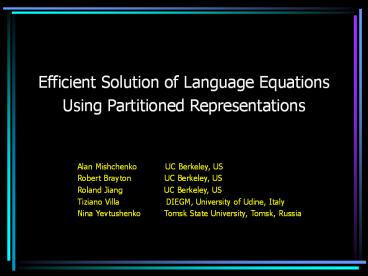Efficient Solution of Language Equations Using Partitioned Representations - PowerPoint PPT Presentation
Title:
Efficient Solution of Language Equations Using Partitioned Representations
Description:
Nina Yevtushenko Tomsk State University, Tomsk, Russia. 2. Overview. Problem formulation ... model fixed .inputs v z .outputs Acc .mv v 2 wait go .mv z 3 red ... – PowerPoint PPT presentation
Number of Views:55
Avg rating:3.0/5.0
Title: Efficient Solution of Language Equations Using Partitioned Representations
1
Efficient Solution of Language Equations Using
Partitioned Representations
- Alan Mishchenko UC Berkeley, US
- Robert Brayton UC Berkeley, US
- Roland Jiang UC Berkeley, US
- Tiziano Villa DIEGM, University
of Udine, Italy - Nina Yevtushenko Tomsk State University,
Tomsk, Russia
2
Overview
- Problem formulation
- Example Traffic light controller
- Partitioned representation
- Solution based on partitioned representation
- Experimental results
- Conclusion
3
Problem Formulation
Specification S (i,o) Fixed F
(i,v,u,o) Unknown X (u,v)
Problem Given S and F, find the Most General
Solution (MGS) X of
Solution
4
Computing Most General FSM Solution
Input Prefix-closed specification S(i,o) and
fixed part F(i,v,u,o) Output Most general FSM
(prefix-closed progressive) solution X begin 01 X
Complete( S ) 02 X Determinize( X ) 03 X
Complement( X ) 04 X Support( X, (i,v,u,o)
) 05 X Product( Complete(F), X ) 06 X
Support( X, (u,v) ) 07 X Determinize( X ) 08 X
Complete( X ) 09 X Complement( X ) 10 X
PrefixClose( X ) 11 X Progressive( X, u )
12 return X end
5
Example Traffic Light Controller
General Topology
This example
Specification
Specification
S
S
I
O
z
Fixed
Fixed
F
F
U
V
v
Unknown
Unknown
X
X
6
Traffic Light Controller (Fixed Part)
- .model fixed
- .inputs v z
- .outputs Acc
- .mv v 2 wait go
- .mv z 3 red green yellow
- .mv CS, NS 3 Fr Fg Fy
- .latch NS CS
- .reset CS
- Fr
- .table -gtAcc
- 1
- .table v z CS -gtNS
- wait red Fr Fr
- go red Fr Fg
- wait green Fg Fg
- go green Fg Fy
- wait yellow Fy Fy
- go yellow Fy Fr
- .end
z red, green, yellow v wait, go
7
Traffic Light Controller (Spec)
- .model spec
- .inputs z
- .outputs Acc
- .mv z 3 red green yellow
- .mv CS,NS 4 S1 S2 S3 S4
- .table -gtAcc
- 1
- .latch NS CS
- .reset CS
- S1
- .table z CS -gtNS
- red S1 S2
- red S2 S3
- green S3 S4
- yellow S4 S1
- .end
z red, green, yellow v wait, go
8
Traffic Light Controller (Synthesis Script)
- echo "Synthesis ..."
- determinize -lci spec.mva spec_dci.mva
- support v(2),z(3) spec_dci.mva spec_dci_supp.mva
- support v(2),z(3) fixed.mva fixed_supp.mva
- product -l fixed_supp.mva spec_dci_supp.mva p.mva
- support v(2) p.mva p_supp.mva
- determinize -lci p_supp.mva p_dci.mva
- progressive -i 0 p_dci.mva x.mva
- echo "Verification ..."
- support v(2),z(3) x.mva x_supp.mva
- product x_supp.mva fixed_supp.mva prod.mva
- support v(2),z(3) spec.mva spec_supp.mva
- check prod.mva spec_supp.mva
9
Traffic Light Controller (Solution)
- .model solution
- .inputs v
- .outputs Acc
- .mv v 2 wait go
- .mv CS, NS 4 \
- FrS1 FrS2 FgS3 FyS4
- .latch NS CS
- .reset CS
- FrS1
- .table -gtAcc
- 1
- .table v CS -gtNS
- wait FrS1 FrS2
- go FrS2 FgS3
- go FgS3 FyS4
- go FyS4 FrS1
- .end
z red, green, yellow v wait, go
10
Partitioned Representation
Fixed part
Output functions oj Oj(i,v,cs) Transition
functions nsk NSk(i,v,cs) Communication
functions um Um(i,v,cs)
11
Computing with Partitioned Representation
- Completion
- Complementation
- Product computation
- Changing support
- Determinization (subset construction)
12
Completion
The output relation is O(i,o,cs) ?joj ?
Oj(i,cs) For each current state cs, the
transitions are not defined iff P(i,o)
?csO(i,o,cs) ?(cs) Using partitioned
representation, which computation is P(i,o)
?cs?joj ? Oj(i,cs) ?(cs) This is a
partitioned image computation.
13
Complementation
- For non-deterministic automata, requires
determinization - For deterministic automata, make non-accepting
states accepting, and vice versa - In the case of partitioned representation, the
dont-care state becomes acceptable, other states
become non-acceptable
14
Product Computation
- Combine the partitions of the two components
15
Changing Support (Lifting and Projecting)
- Expanding support is trivial
- Reducing support requires existential
quantification - In general, cannot be done on the partitioned
representation - Therefore, postponed until the determinization
step
16
Determinization (Subset Construction)
- Start with the subset containing only the initial
state. - For each subset ?, compute the subsets reachable
through (u, v). - Define the acceptance relation
- Compute the condition of the transition is into
non-accepting states - Restrict the transitions to those that are not
contained in Q(u, v) - Direct the transition under Q(u, v) to DCN.
- Complete and redirect the remaining transitions
to DCA.
17
Experimental Results
Name is the ISCAS benchmark name i/o/cs is the
number of input/output/state variables Fcs/Xcs is
the partitioning of the state variables States(X)
is the number of states in the solution Mono is
the runtime of the monolithic computation in
seconds Part is the runtime of partitioned
computation is in seconds Ratio is improvement
due to the proposed method
18
Conclusions
- Introduced language solving problems
- Showed a simple example
- Discussed partitioned representation
- Presented experimental results
19
Future Work
- Developing methods for finding a particular
solution contained in the most general solution - Developing efficient sequential synthesis methods
without state space traversal































